NVIDIA’s GeForce GTX 480 and GTX 470: 6 Months Late, Was It Worth the Wait?
by Ryan Smith on March 26, 2010 7:00 PM EST- Posted in
- GPUs
Temperature, Power, & Noise: Hot and Loud, but Not in the Good Way
For all of the gaming and compute performance data we have seen so far, we’ve only seen half of the story. With a 500mm2+ die and a TDP over 200W, there’s a second story to be told about the power, temperature, and noise characteristics of the GTX 400 series.

Starting with idle temperatures, we can quickly see some distinct events among our cards. The top of the chart is occupied solely by AMD’s Radeon 5000 series, whose small die and low idle power usage let these cards idle at very cool temperatures. It’s not until half-way down the chart that we find our first GTX 400 card, with the 470 at 46C. Truth be told we were expecting something a bit better out of it given that its 33W idle is only a few watts over the 5870 and has a fairly large cooler to work with. Farther down the chart is the GTX 480, which is in the over-50 club at 51C idle. This is where NVIDIA has to pay the piper on their die size – even the amazingly low idle clockspeed of 50MHz/core 101MHz/shader 67.5Mhz/RAM isn't enough to drop it any further.

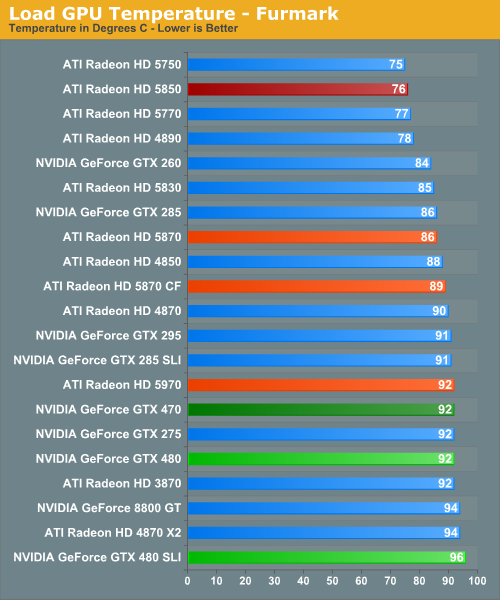
For our load temperatures, we have gone ahead and added Crysis to our temperature testing so that we can see both the worst-case temperatures of FurMark and a more normal gameplay temperature.
At this point the GTX 400 series is in a pretty exclusive club of hot cards – under Crysis the only other single-GPU card above 90C is the 3870, and the GTX 480 SLI is the hottest of any configuration we have tested. Even the dual-GPU cards don’t get quite this hot. In fact it’s quite interesting that unlike FurMark there’s quite a larger spread among card temperatures here, which only makes the GTX 400 series stand out more.
While we’re on the subject of temperatures, we should note that NVIDIA has changed the fan ramp-up behavior from the GTX 200 series. Rather than reacting immediately, the GTX 400 series fans have a ramp-up delay of a few seconds when responding to high temperatures, meaning you’ll actually see those cards get hotter than our sustained temperatures. This won’t have any significant impact on the card, but if you’re like us your eyes will pop out of your head at least once when you see a GTX 480 hitting 98C on FurMark.
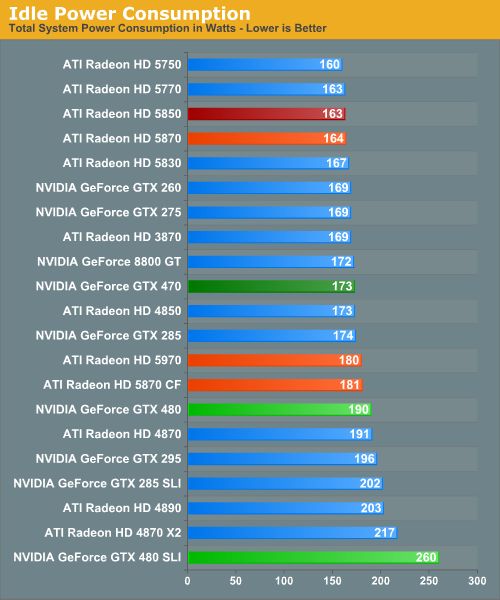
Up next is power consumption. As we’ve already discussed, the GTX 480 and GTX 470 have an idle power consumption of 47W and 33W respectively, putting them out of the running for the least power hungry of the high-end cards. Furthermore the 1200W PSU we switched to for this review has driven up our idle power load a bit, which serves to suppress some of the differences in idle power draw between cards.
With that said the GTX 200 series either does decently or poorly, depending on your point of view. The GTX 480 is below our poorly-idling Radeon 4000 series cards, but well above the 5000 series. Meanwhile the GTX 470 is in the middle of the pack, sharing space with most of the GTX 200 series. The lone outlier here is the GTX 480 SLI. AMD’s power saving mode for Crossfire cards means that the GTX 480 SLI is all alone at a total power draw of 260W when idle.
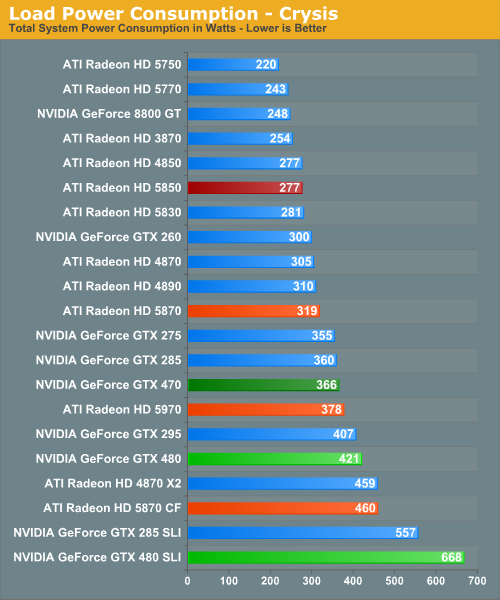
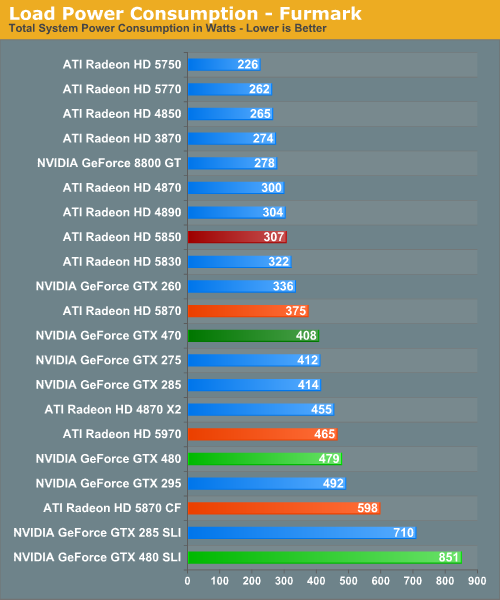
For load power we have Crysis and FurMark, the results of which are quite interesting. Under Crysis not only is the GTX 480 SLI the most demanding card setup as we would expect, but the GTX 480 itself isn’t too far behind. As a single-GPU card it pulls in more power than either the GTX 295 or the Radeon 5970, both of which are dual-GPU cards. Farther up the chart is the GTX 470, which is the 2nd most power draining of our single-GPU cards.
Under FurMark our results change ever so slightly. The GTX 480 manages to get under the GTX 295, while the GTX 470 falls in the middle of the GTX 200 series pack. A special mention goes out to the GTX 480 SLI here, which at 851W under load is the greatest power draw we have ever seen for a pair of GPUs.

Idle noise doesn’t contain any particular surprises since virtually every card can reduce its fan speed to near-silent levels and still stay cool enough. The GTX 400 series is within a few dB of our noise floor here.
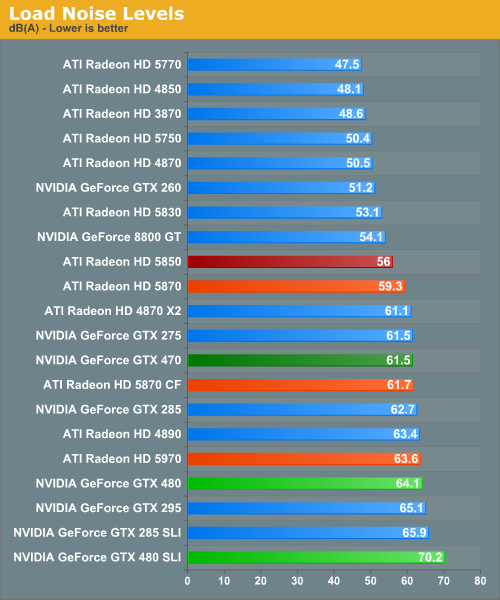
Hot, power hungry things are often loud things, and there are no disappointments here. At 70dB the GTX 480 SLI is the loudest card configuration we have ever tested, while at 64.1dB the GTX 480 is the loudest single-GPU card, beating out even our unreasonably loud 4890. Meanwhile the GTX 470 is in the middle of the pack at 61.5dB, coming in amidst some of our louder single-GPU cards and our dual-GPU cards.
Finally, with this data in hand we went to NVIDIA to ask about the longevity of their cards at these temperatures, as seeing the GTX 480 hitting 94C sustained in a game left us worried. In response NVIDIA told us that they have done significant testing of the cards at high temperatures to validate their longevity, and their models predict a lifetime of years even at temperatures approaching 105C (the throttle point for GF100). Furthermore as they note they have shipped other cards that run roughly this hot such as the GTX 295, and those cards have held up just fine.
At this point we don’t have any reason to doubt NVIDIA’s word on this matter, but with that said this wouldn’t discourage us from taking the appropriate precautions. Heat does impact longevity to some degree – we would strongly consider getting a lifetime warranty for the GTX 480 to hedge our bets.










196 Comments
View All Comments
WiNandLeGeNd - Saturday, March 27, 2010 - link
I think this was a great review, as mentioned previously, very objective. I think though that I may get a 480, because when I buy a card I keep it for 3 to 4 years before I get a new one, aka every other gen. And seeing that tessellation is really the gift horse of DX11 and how much more tessellation power is in the 480's, I think it could very much pay off in the future. If not then I spent an extra $85 for a tad extra performance as I just pre-ordered one for 485 and the 5870's are at $400 still.My only concern is heat and power, but most of the cards have a life time warranty. Hopefully my OCZ GamerXtreme 850W can handle it at max loads. The two 12v rails for the two 6 pin PCI-X connectors are 20 A each, I saw 479w max consumption, however that was furmark, at 12v that's 39.5 amps, so it would be extremely close if there is ever a game to utilize that much power. Although If I recall ATI specifically stated a while back to not use that as it pushes loads that are not possible to see in an actual game, I think they had an issue with the 4000 series burning out power regulators, correct me if I'm wrong.
Alastayr - Saturday, March 27, 2010 - link
I'm with sunburn on this one. Your reasoning doesn't make much sense. You must've not followed the GPU market for the last few years becausefirst) "every other gen" would mean a 2 year cycle
second) Nothing's really gonna pay off in the future, as the future will bring faster cards for a fraction of the price. You'd only enjoy those questionable benefits until Q4, when AMD releases Northern Islands and nVidia pops out GF100b or whatever they'll call it.
third) Tessellation won't improve further that fast. If at all, developers will focus on the lowest common denominator, which would be Cypress. Fermi's extra horse power will most likely stay unused.
fourth) Just look at your power bill. The 25W difference with a "typical" Idle scheme (8h/day; 350d/y) comes to 70kWh which where I live translates to around $20 per year. That's Idle *only*. You're spending way more than just $85 extra on that card.
fifth) The noise will kill you. This isn't a card than just speeds up for no reason. You can't just magically turn down the fan from 60% to 25% and still enjoy Temps of <90°C like on some GTX 260 boards. Turn up your current fan to 100% for a single day. Try living through that. That's probably what you're buying.
In the end everyone has to decide this for himself. But for someone to propose keeping a GTX 480 in his PC for a whopping 3-4 years... I don't know man. I'd rather lose a finger or two. ;)
tl;dr I know, I know. But really people. Those cards aren't hugely competetive, priced too high and nV's drivers suck as much as ATi's (allegedly) do nowadays. Whis is to say neither do.
I could honestly bite me right now. I had a great deal for a 5850 in Nov. and I waited for nV to make their move. Now the same card will cost me $50 more, and I've only wasted time by waiting for the competetive GTX 470 that never was. Argh.
Sunburn74 - Saturday, March 27, 2010 - link
Thats kind of bad logic imo. I'm not fanboy on either side, but it's clear to me that Nvidia targeted the performance of their cards to fit in exactly between the 5970, the 5870, and 5850. Its much harder to release a card not knowing what the other guy truly has as opposed to releasing a card knowing exactly what sort of performance levels you have to hit.Two, realistically, think of the noise. I mean ifyou've ever heard a gtx 260 at 100 percent fan speed, thats the sort of fan noises you're going to be experiencing on a regular basis. Its not a mild difference.
And three, realistically for the premium you're paying for the extra performance (which is not useful right now as there are no games to take advantage of it) as well as for the noise, heat and power, you could simply buy the cheaper 5870, save that 85-150 dollars extra, and sell off the 5870 when the time is right.
I just don't see why anyone would buy this card unless they were specifically taking advantage of some of the compute functions. As a consumer card it is a failure. Power and heat be damned, the noise the noise! Take your current card up to 100 percent fan speed, and listen to it for a few mins, and thats what you should about expect from these gpus.
andyo - Saturday, March 27, 2010 - link
I too am getting the warning message with Firefox 3.6.2. Posting this on IE. Here's the message:http://photos.smugmug.com/photos/820690277_fuLv6-O...">http://photos.smugmug.com/photos/820690277_fuLv6-O...
JarredWalton - Saturday, March 27, 2010 - link
We're working on it. Of course, the "Internet Police" have now flagged our site as malicious because of one bad ad that one of the advertisers put up, and it will probably take a week or more to get them to rescind the "Malware Site" status. Ugh....jeffrey - Saturday, March 27, 2010 - link
Give the advertiser that put up the bad ad hell!LedHed - Saturday, March 27, 2010 - link
The people who are going to buy the GTX 480/470 are enthusiast who most likely bought the GTX 295 or had 200 Series SLI. So not including the 295 in every bench is kind of odd. We need to see how the top end of the last gen does against the new gen top end.Ryan Smith - Saturday, March 27, 2010 - link
What chart is the 295 not in? It should be in every game test.kc77 - Saturday, March 27, 2010 - link
Well the 295 beats the 470 in most benches so there's no need to really include it in all benches. Personally I think the 480 is the better deal. Although I am not buying those cards until a respin/refresh, those temps and power requirements are just ridiculous.bigboxes - Saturday, March 27, 2010 - link
I know you "upgraded" your test PSU to the Antec 1200W PSU, but did you go back and try any of these tests/setups with your previous 850W PSU to see if could handle the power requirements. It seemed that only your 480 SLI setup drew 851W in total system in the Furmark load test. Other than that scenario it looks like your old PSU should handle the power requirements just fine. Any comments?